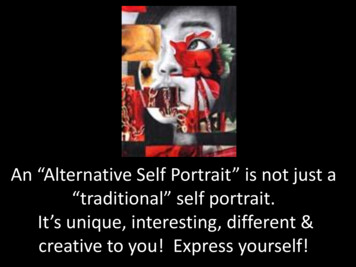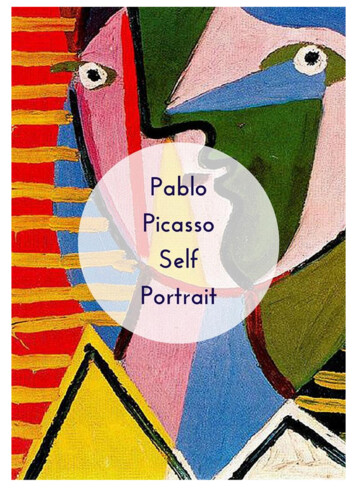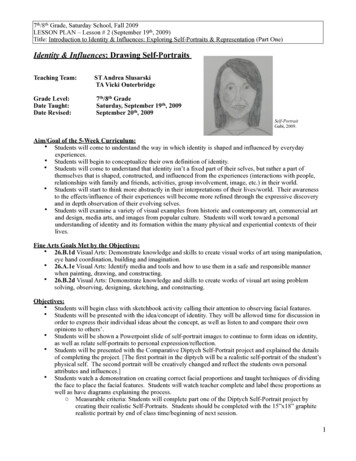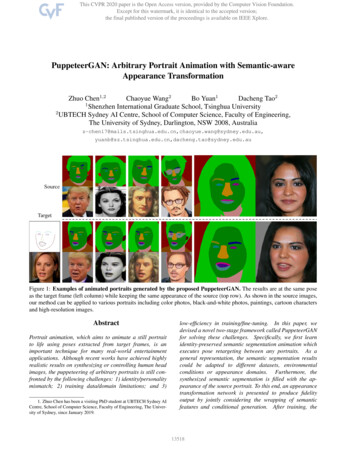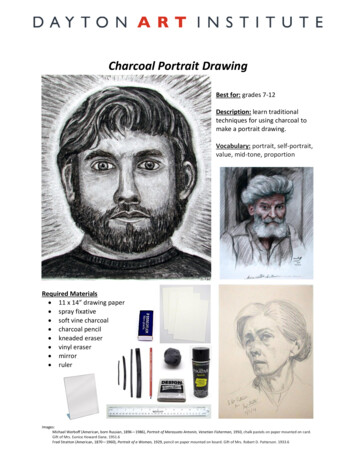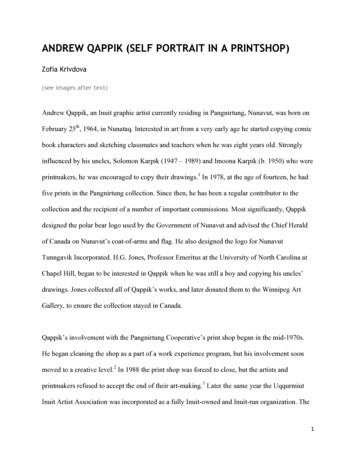
Transcription
ANDREW QAPPIK (SELF PORTRAIT IN A PRINTSHOP)Zofia Krivdova(see images after text)Andrew Qappik, an Inuit graphic artist currently residing in Pangnirtung, Nunavut, was born onFebruary 25th, 1964, in Nunataq. Interested in art from a very early age he started copying comicbook characters and sketching classmates and teachers when he was eight years old. Stronglyinfluenced by his uncles, Solomon Karpik (1947 – 1989) and Imoona Karpik (b. 1950) who wereprintmakers, he was encouraged to copy their drawings.1 In 1978, at the age of fourteen, he hadfive prints in the Pangnirtung collection. Since then, he has been a regular contributor to thecollection and the recipient of a number of important commissions. Most significantly, Qappikdesigned the polar bear logo used by the Government of Nunavut and advised the Chief Heraldof Canada on Nunavut’s coat-of-arms and flag. He also designed the logo for NunavutTunngavik Incorporated. H.G. Jones, Professor Emeritus at the University of North Carolina atChapel Hill, began to be interested in Qappik when he was still a boy and copying his uncles’drawings. Jones collected all of Qappik’s works, and later donated them to the Winnipeg ArtGallery, to ensure the collection stayed in Canada.Qappik’s involvement with the Pangnirtung Cooperative’s print shop began in the mid-1970s.He began cleaning the shop as a part of a work experience program, but his involvement soonmoved to a creative level.2 In 1988 the print shop was forced to close, but the artists andprintmakers refused to accept the end of their art-making.3 Later the same year the UqqurmiutInuit Artist Association was incorporated as a fully Inuit-owned and Inuit-run organization. The1
artists started raising funds to build a new arts centre. The Uqqurmiut Centre for Arts and Craftsbecame a reality over the winter of 1990-91.4Having introduced Andrew Qappik, I will now focus this paper on an analysis of Self-Portrait inPrintshop (2003). The most significant visual elements of this print is design. The shapes in thisprint are geometric and linear. Rectangles are the prevailing pattern in the composition, formingthe floor of the studio, the windows, the prints on the wall, and the actual outline of the printshop. The circle of the printing machine is echoed in the logo on the artist’s T-shirt and themovement of his arms. The space portrayed here is three-dimensional, with the artist working onthe printing machine in the foreground, the wall of the printshop with four of Qappik’s works inthe middleground, and the landscape seen from the window of the shop in the background. Thisimage is unusual of his practice in two ways. Firstly, it is a black-and-white image which is nottypical for his works, in that his prints are usually quite colourful. Secondly, this is the only selfportrait of the artist. This being said, this image can also be seen as more than a self-portrait. As Iwill explain in my discussion below, this self portrait is also a portrait of the Inuit to-day. I willargue that through the inclusion of Qappik’s other prints represented on the walls of theprintshop that portray traditional Inuit subjects like the land and its animals, the artist in this selfportrait actively preserves the Inuit heritage and culture.Andrew Qappik has a special affinity with the traditional Inuit way of subsistence—followingwildlife and surviving on what nature provides. His prints capture images of the “old ways,”what he learned about past Inuit life from his elders. By addressing these issues in his work, hepreserves the traditional Inuit way of life, the respect for the land, its animals, and for family and2
ancestors. He links traditional and contemporary elements in bold and appealing images andfuses traditional themes with contemporary concerns.5The theme common to most of his prints is the depiction of the artist’s experiences on the land.Landscape in the background is a common element in many of his prints. The landscape isvisible in his Self-portrait in Printshop from the window of the print shop where he is working.This depiction of landscape is not common in the older generations of artists. Marion Jacksonrecognizes two generations of Inuit printmakers.6 The first generation of artists were born on theland, and their worldview is based on the traditional way of life on the land. Their prints arecharacterized by the isolation of images in a void, the repetition of motif, and the use of multipleperspectives. The second generation of artists combine memories of land with the realities of lifein a permanent settlement in which southern influences predominate. The third generation ofartists, not considered by Jackson, is introduced by Annalisa R. Seagrave. These artists blend theWestern techniques with a unique Inuit vision. The stylistic trails of the second generation maybe applied, but each artist has their own individual style. Andrew Qappik is an example of athird-generation artist. The southern influence is visible in his works for example in the influenceof comic books on his interpretation of animal forms and the fact that in his self portrait, he isdressed in contemporary Western clothing. At the same time, he uses multiple perspectives inmany of his prints, some of which we can see on the walls of the print shop and in this selfportrait, thus echoing the art of the first generation of artists. Darlene Wight, curator of Inuit artat the Winnipeg Art Gallery, noted that Qappik often plays with perspective, using a bird’s eyeview looking down, and focuses on details like the splashing water left by the wake of a boat:“He uses very western techniques of drawing, like three-point perspective, shading to give three-3
dimensionality to his works. When people think of Inuit works, prints, they think of flat imageson the white paper. He puts his images into full landscapes, which is not typical.”7 Furthermore,in his focus on animals he refers to the traditional ways of life of the Inuit. Artists like Qappikhelp to ensure that the essential values of Inuit culture are maintained, even though rapid changehas ruptured Inuit ways of life.In these prints, Qappik pays tribute to the animals on which his people have depended for food,and continue to depend for sustenance and cultural survival.8 These images illustrate the intimateconnections between people and animals. Under My Wings (2001) can be seen in the SelfPortrait in Printshop at the top left of the image. It is a picture of a bird that looks like an owl,with its baby. The baby is looking up at her mother, and the mother returns the loving gaze.Qappik uses very soft colours in this print, mostly very light shades of pink, green, brown andblue. The print reflects his knowledge of one of the most well-known early Inuit printmakers,Kenojuak Ashevak (b. 1927), whose imaginative drawings, prints and carvings of animals reflecther experiences and life in the North. While her imagery is varied, she is best known for herbirds, such as Guardian Owl (1980). This print, an example of the style of the first generation ofartists is reflected in two main ways in Under My Wings: in the background without a landscapeand intimate portrayal of animals. Similarly, Qappik’s deep respect for animal life is reflected inhis touching scenes of polar bears with their cubs. His Sleeping Bear (2002) depicts a sleepingpolar bear in an Inuit landscape of ice and snow. A very similar print is featured on the wall ofSelf-portrait in Printshop. Another recurring subject in his prints is family. This is illustrated inhis 2002 print Warmth and Sounds of Summer. This is an image of two women and their babies,interacting with each other in a landscape of soaring birds. Qappik echoes the traditional Inuit art4
here in the absence of the landscape in the background of the scene. This print can also be seenin Self Portrait in Printshop, on the wall of his studio. The importance of family is also portrayedin Mother and Son (2002). The drawing was made by Samantha Qappik, Andrew’s daughter, andAndrew turned it into a print. It shows a mother with her baby, sleeping in the hood of her parka.The black hair of the woman is highly stylized into two braids at each side of her face. Her facialfeatures are very expressive, with dotted lines around her nose, under her mouth and on herforehead. The baby’s little head seems to be connected to the woman’s head, suggesting a veryintimate bond. The touches of soft pink and blue colours create a rainbow-like vibrancy.The portrait of a people and communal living is constructed out of images, stories and legends.John Berger states that: “What distinguishes the life of a village is that it is also a living portraitof itself constructed out of opinions, stories, eye-witness reports, legends, comments andhearsay Without such a portrait the village would have been forced to doubt its ownexistence.”9 In his writing about village peasants, Berger explains that “My writing aboutpeasants separates me from them and brings me close to them.”10 Unlike Berger, Qappik is notseparate from his community. At the same time his prints reaffirm his participation in the “Inuitexperience,” bringing him closer to it—by creating these personal artistic responses to Inuit life.5
Andrew Qappik (Self Portrait in a Printshop). 2003Andrew Qappik (1964- )Drypoint print, 35 x 40.5 cm.Library and Archives Canada, archival reference number R11347-1 http://collectionscanada.gc.ca/pam archives/index.php?fuseaction genitem.displayEcopies&lang eng&rec nbr 623540 .6
Under my Wings. 2001Andrew Qappik (1964- )Stencil, 48 x 38 cmUqqurmiut Centre for Arts and Crafts http://www.uqqurmiut.com/2001 prints pages/2001print30.html .7
Guardian Owl, 1980Kenojuak AshevakLithograph, 55. 9 x 78. 7 cmGalerie Elca London, Art Inuit http://www.elcalondon.com/dynamic/artwork display.asp?ArtworkID 302 .8
Sleeping Bear. 2002Andrew Qappik (1964- )Stencil, 54 x 70 cmUqqurmiut Centre for Arts and Crafts http://www.uqqurmiut.com/2002 prints pages/2002print28.html .9
Warmth and Sounds of Summer. 2002Andrew Qappik (1964- )Stencil, 52 x 67 cmUqqurmiut Centre for Arts and Crafts http://www.uqqurmiut.com/2002 prints pages/2002print29.html .10
Mother and Son. 2002Samantha QappikPrint by Andrew Qappik (1964- )Stencil, 34 x 41.5 cmUqqurmiut Centre for Arts and Crafts http://www.uqqurmiut.com/2002 prints pages/2002print31.html .11
NOTES1 Andrew Qappik changed his name from Karpik to conform with modern orthography: Darlene CowardWight, “Andrew Qappik: Memory and Reality,” Pangnirtung Memories (Winnipeg: Winnipeg ArtGallery, 2010) 11.2 Darlene Coward Wight. “Andrew Qappik: Memory and Reality,” Pangnirtung Memories (Winnipeg:Winnipeg Art Gallery, 2010) 11.3 Wight, 13.4 Wight, 13.5 Jane Sproull Thomson and Luke Ratzlaff, “Andrew Qappik’s Contemporary Arctic Visions,” Inuit ArtQuarterly 20:4 (Winter 2005): 10.6 Annalisa R. Seagrave, “Regenerations: The Graphic Art of Three Young Artists,” Inuit Art Quarterly13:4 (Winter 1998): 4.7 Jane George, “Meet Andrew Qappik, the artist’s artist,” Nunatsiaq Online (2 May 2010) http://www.nunatsiaqonline.ca/stories/article/8978 meet andrew qappik the artists artist/ .8 H.G. Jones, “Andrew Qappik: A Collector’s Perspective,” Pangnirtung Memories (Winnipeg: WinnipegArt Gallery, 2010) 8.9 John Berger, Pig Earth 9; Bruce Robbins, “Feeling Global: Experience and John Berger,” Boundary 211:1/2 (Autumn 1982-Winter 1983): 299.10 John Berger, Pig Earth 6-7; Bruce Robbins, “Feeling Global: Experience and John Berger,” Boundary2 11:1/2 (Autumn 1982-Winter 1983): 299.12
BIBLIOGRAPHYCoward Wight, Darlene. “Andrew Qappik: Memory and Reality.” Pangnirtung Memories.Winnipeg: Winnipeg Art Gallery, 2010.George, Jane. “Meet Andrew Qappik, The Artist’s Artist.” Nunatsiaq Online (2 May 2010) http://www.nunatsiaqonline.ca/stories/article/8978 meet andrew qappik the artists artist/ .I can make art Like Andrew Qappik. Dir. Jane Churchill. National Film Board of Canada(2005) http://www.nfb.ca/film/i can make art like andrew qappik .Inuit Art Foundation. “The Artist: Qappik, Andrew.” Inuit Art Alive (2011) 30 Nov. 2011. http://www.inuitartalive.ca/index e.php?p 279 .Jones, H.G. “Andrew Qappik: A Collector’s Perspective.” Pangnirtung Memories. Winnipeg:Winnipeg Art Gallery, 2010.McCuaig, Adria Cowell. Arctic-Adapted Art Education: Looking at the Art EducationExperiences and Efforts of Inuit Artist Andrew Qappik. Master of Arts Thesis. University ofTexas at Austin. -UT-2009-08312?show full .Robbins, Bruce. “Feeling Global: Experience and John Berger.” Boundary 2 11:½ (Autumn1982-Winter 1983): 291-308.Seagrave, Annalisa R. “Regenerations: The Graphic Art of Three Young Artists.” Inuit ArtQuarterly 13:4 (Winter 1998): 4-15.Thomson, Jane Sproull, and Luke Ratzlaff. “Andrew Qappik’s Contemporary Arctic Vision.”Inuit Art Quarterly 20:4 (Winter 2005): 10-16.Uqqurmiut Centre for Arts and Crafts. The Uqqurmiut Inuit Artists Association. 30 Nov. 2011. http://www.uqqurmiut.com/index.html .13
2" " artists started raising funds to build a new arts centre. The Uqqurmiut Centre for Arts and Crafts became a reality over the winter of 1990-91.4 Having introduced Andrew Qappik, I will now focus this paper on an analysis of Self-Portrait in Printshop (2003). The



